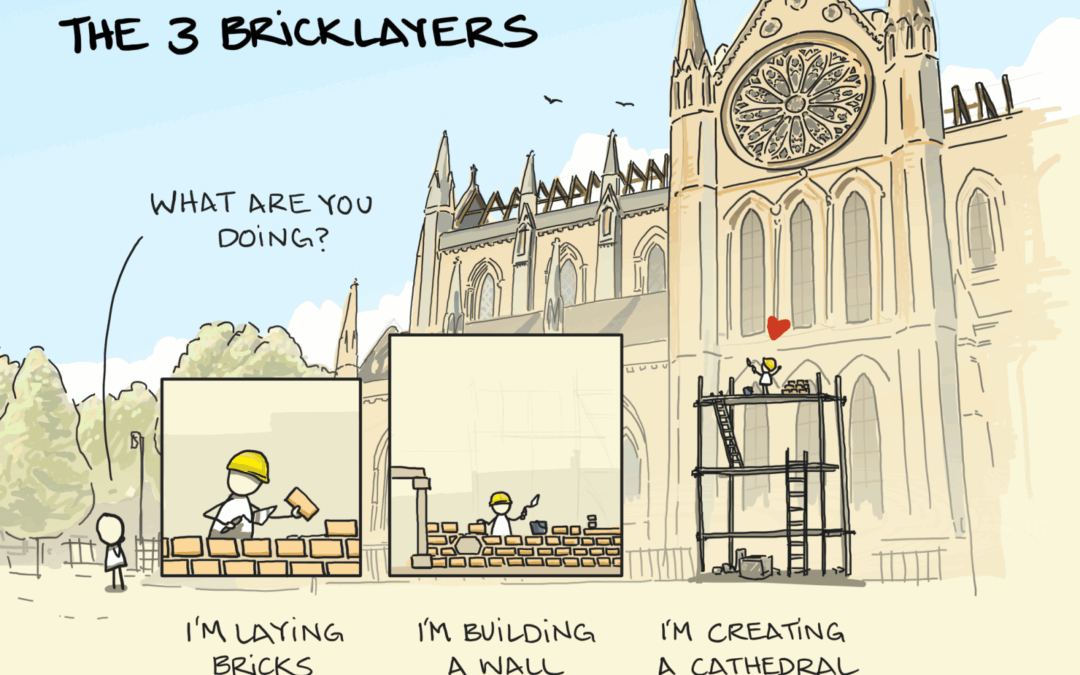
by Robyn Bolton | Dec 16, 2025 | Just for Fun, Leadership, Tips, Tricks, & Tools, Uncategorized
Everybody loves a Top X list. This past week I’ve read the Top 100 Best Comedy Movies of All Time, The 100 Best Episodes of the Century, and the NYT’s 100 Notable Books of 2025. And all this before we’re inundated with the Top 10 lists sports, politics, celebrity news, world news, and whatever other topic a writer can dream up.
Top X Lists are about big things, events that affect everyone or that will be remembered for decades. And while those Macro-moments are what stand out in our memories, they rarely define our everyday existence.
What are Micro-moments?
I first heard of Micro-moments in an interview between Dan Shipper, founder of Every, and Henrik Werdelin, founder of Prehype (and incubator that helped launch Barkbox and Ro Health). According to Werdelin:
Micro-moments for me are things when I’m in flow and things where I’m happy. It can’t be a big thing like having a family. It has to be a very concrete things like I like walking over the Brooklyn Bridge in the morning. It’s just something I get profoundly happy about, right? Or I like being in brainstorm meetings with (other entrepreneurs)
But his list of Micro-moments isn’t just a new-age happiness manifestation, it’s an actual decision-making tool. Werdelin explains:
I was basically trying to figure out what to do next and I was keeping all my options open. I got offered a job to run BBC Digital on the international side and then I got offered a job at a design agency called Wolf Collins who had an incredible CEO.
And so, I ended up having these 30 concrete [moments] where I’ve done stuff and then I started to use that as a way to measure options that would be thrown at me. The BBC sounded like it would be a lot of money, and it was like a cool job, and it would give me, I guess, self-esteem for a second. But then when I looked at what it would entail, none of the Micro-moments would be included so I was like, “ah, probably not for me.”
My first Micro-reactions
- Eye roll: Thank goodness you had a list of Micro-moments so you could avoid the soul sucking horror of running BBC Digital!
- Righteous indignation: Do you have any idea how hard it is out there to find a job? People would be thrilled to have a job that delivers only ONE Micro-moment of happiness?!
- Breathe: What a second. What if Mico-moments don’t determine your role. What if Micro-moments…perhaps…mean a little bit more! (yes, that is a terrible rephrasing of the Grinch’s epiphany)
Micro-moments are more than moments of flow and joy. They’re the moments that make up our lives, relationships, and view of the world. They’re the moments that should be on our Top 10 lists but too often get crowded out by noisier, bigger moments.
They’re also things we can create, design for, and sometimes even control.
What are YOUR Micro-moments?
As the period of end-of-year reflection approaches, think about your Micro-moments. What small, concrete moments that brought you flow, joy, or peace, this year? Where were you? What were you doing? Who were you with? Jot them down
When the new year dawns, go back to your list and get curious. What are the common themes, people, places, and activities in your Micro-moments. Write down what you notice.
As the year kicks into gear and everyone settles back into work and school routines, return to your list and start planning. How might you create more Micro-moments?
Life is made up of moments. Many of them are beyond our control. But some of them aren’t. And wouldn’t it be great to know which ones make us happiest so we can experience them more often?

by Robyn Bolton | Nov 11, 2025 | Leadership, Leading Through Uncertainty
The business press has a new obsession with courageous leadership.
Harvard Business Review dedicated their September cover story to it. Nordic Business Forum built an entire 2024 conference around it. BetterUp, McKinsey, and dozens of thought leaders and influencers can’t stop talking about it.
Here’s what they’re all telling you: If you’re playing it safe, stuck in analysis paralysis, not innovating fast enough, or not making bold moves, then you are the problem because you lack courage.
Here’s what they’re not telling you: You don’t have a courage problem. You have a systems problem.
The Real Story Behind “Courage Gaps”
The VP was anything but cowardly. She had a track record of bold moves and wasn’t afraid of hard conversations. The CEO wanted to transform the company by moving from a product-only focus to one offering holistic solutions that combined hardware, software, and services. This VP was the obvious choice.
Her team came to her with a ideas that would reposition the company for long-term growth. She loved it. They tested the ideas. Customers loved them. But not a single one ever launched.
It wasn’t because the VP or the CEO lacked courage. It was because the board measured success in annual improvements, the CEO’s compensation structure rewarded short-term performance, and the VP required sign-off from six different stakeholders who were evaluated on risk mitigation. At every level, the system was designed to kill bold ideas. And it worked.
This is the inconvenient truth the courage press ignores.
That success doesn’t just require leaders who are courageous, it requires organizational architecture that systematically rewards courage and manages risk.
What We’re Really Asking Leaders to Overcome
Consider what we’re actually asking leaders to be courageous against:
- Compensation structures tied to short-term metrics
- Risk management processes designed to say “no”
- Approval hierarchies where one skeptic can overrule ten enthusiasts
- Cultures where failed experiments end careers
The courage discourse lets broken systems off the hook.
It’s easier to sell “10 Ways to Build Leadership Courage” than to admit that organizational incentives, governance structures, and cultural norms are actively working against the bold moves we tell leaders to make.
What Actually Enables Courageous Leadership.
I’m not arguing that there isn’t a need for individual courage. There is.
But telling someone to “be braver” when their organizational architecture punishes bravery is like telling someone to swim faster in a pool filled with Jell-O.
If we want courage, we need to fix the things the systems that discourage it:
- Align incentives with the time horizon of the decisions you want made
- Create explicit permission structures for experimentation
- Build decision-making processes that don’t require unanimous consent
- Separate “learning investments” from “performance expectations” when measuring results
- Make the criteria for bold moves clear, not subject to whoever’s in the room
But doing this is a lot harder than buying books about courage.
The Bottom Line
When you fix the architecture, you don’t need to constantly remind people to be brave because the system enables. Individual courage becomes the expectation, not the exception.
The real question isn’t whether your leaders need courage.
It’s whether your organization has the architecture to let them use it.
If you can’t answer that question, that’s not a courage problem.
That’s a design problem.
And design is something that, as a leader, you can actually control.

by Robyn Bolton | Oct 28, 2025 | Leadership, Strategy
Last week, I shared that 74% of executives believe that their organizations will cease to exist in ten years. They believe that strategic transformation is required, but cite the obvious problem of organizational inertia and the easy scapegoat of people’s resistance to change.
Great. Now we know the problem. What’s the solution?
The Obvious: Put the Right People in Leadership Roles
Flipping through the report, the obvious answers (especially from an executive search firm) were front and center:
- Build a top team with relevant experience, competencies, and diverse backgrounds
- Develop the team and don’t be afraid to make changes along the way
- Set a common purpose and clear objectives, then actively manage the team
The Easy: Do Your Job as a Leader
OK, these may not be easy but it’s not that hard, either:
- Relentlessly and clearly communicate the why behind the change
- Change one thing at a time
- Align incentives to desired outcomes and behaviors
- Be a role model
- Understand and manage culture (remember, it’s reflected in the worst behaviors you tolerate)
The Not-Obvious-or-Easy-But-Still-Make-or-Break: Deputize the Next Generation
Buried amongst the obvious and easy was a rarely discussed, let alone implemented, choice – actively engaging the next generation of leaders.
But this isn’t the usual “invite a bunch of Hi-Pos (high potentials) to preview and upcoming announcement or participate in a focus group to share their opinions” performance most companies engage in.
This is something much different.
Step 1: Align on WHY an “extended leadership team” of Next Gen talent is mission critical
The C-Suite doesn’t see what happens on the front lines. It doesn’t know or understand the details of what’s working and what’s not. Instead, it receives information filtered through dozens of layers, all worried about positioning things just right.
Building a Next Gen extended leadership team puts the day-to-day realities front and center. It brings together capabilities that the C-Suite team may lack and creates the space for people to point out what looks good on paper but will be disastrous in practice.
Instead, leaders must commit to the purpose and value of engaging the next generation, not merely as “sensing mechanisms” (though that’s important, too) but as colleagues with different and equally valuable experiences and insights.
Step 2: Pick WHO is on the team without using the org chart
High-potentials are high potential because they know how to succeed in the current state. But transformation isn’t about replicating the current state. It requires creating a new state. For that, you need new perspectives:
- Super connecters who have wide, diverse, and trusted relationships across the organization so they can tap into a range of perspectives and connect the dots that most can barely see
- Credible experts who are trusted for their knowledge and experience and are known to be genuinely supportive of the changes being made
- Influencers who can rally the troops at the beginning and keep them motivated throughout
Step 3: Give them a clear mandate (WHAT) but don’t dictate HOW to fulfill it
During times of great change, it’s normal to want to control everything possible, including a team of brilliant, creative, and committed leaders. Don’t involve them in the following steps and be open to being surprised by their approaches and insights:
- At the beginning, involve them in understanding and defining the problem and opportunity.
- Throughout, engage them as advisors and influencers in decision-making (
- During and after implementation, empower them to continue to educate and motivate others and to make adaptations in real-time when needed.
Co-creation is the key to survival
Transforming your organization to survive, even thrive, in the future is hard work. Why not increase your odds of success by inviting the people who will inherit what you create to be part of the transformation?

by Robyn Bolton | Oct 19, 2025 | Leadership, Leading Through Uncertainty
One day, an architect visited the building site of his latest project. There he saw three people all laying bricks. He asked each what they were doing. “I’m laying bricks,” the first responded. “I’m building a wall,” said the second. “I’m building a cathedral,” exclaimed the third.
The parable of the Three Bricklayers is a favorite amongst motivational speakers, urging their audiences to think beyond today’s tasks and this quarter’s goals to commit to a grandiose vision of eternal success and glory.
But there’s a problem.
The narrative changed
The person who had a vision of building a cathedral? They now believe they’re building ruins.
Is the C-Suite Quietly Quitting?
Recently published research found that three out of four executives believe that “without fundamental transformation* their organization will cease to exist” in ten years. That’s based on data from interviews with twenty-four “current or former CEOs who have led successful transformations” and 1,360 survey responses from C-Suite and next-generation leaders.
And, somehow, the news gets worse.
While 77% of C-suite executives report that they’re committed to their companies’ transformation efforts, but 57% believe their organization is taking the wrong approach to that transformation. But that’s still better than the 68% of Next-Gen executives who disagree with the approach.
So, it should come as no surprise that 71% of executives rate their companies’ transformation efforts as not at all to moderately successful. After all, it’s hard to lead people along a path you don’t agree with to a vision you don’t believe in.
Did they just realize that “change is hard in human systems?”
We all fall into the trap of believing that understanding something results in commitment and change.
But that’s not how humans work.
That’s definitely not how large groups of humans, known as organizations, work.
Companies’ operations are driven only loosely by the purpose, structures, and processes neatly outlined in HR documents. Instead, they are controlled by the power and influence afforded to individuals by virtue of the collective’s culture, beliefs, histories, myths, and informal ways of working.
And when these “opaque dimensions” are challenged, they don’t result in resistance,
They result in inertia.
“Organizational inertia kills transformations”
Organizations are “complex organisms” that evolve to do things better, faster, cheaper over time. They will continue doing so unless changed by an external force (yes, that’s Newton’s first law of motion).
That external force, the drive for transformation, must be strong enough to overcome:
- Insight Inertia stops organizations from getting started because there is a lack of awareness or acceptance amongst leaders that change is needed.
- Psychological Inertia emerges when change demands abandoning familiar success strategies. People embrace the idea of transformation but resist personal adaptation, defaulting to comfortable old behaviors.
- Action Inertia sets in and gains power as the long and hard work of transformation drags on. Over time, people grow tired. Exhausted by continuous change, teams progressively disengage, becoming less responsive and decisive.
But is that possible when 74% of executives are simply biding their time and waiting for failure?
“There’s a crack in everything, that’s how the light gets in.”
Did you see the crack in all the doom and gloom above?
- 43% of executives believe their organizations are taking the right approach to transformation.
- 29% believe that their organizations’ transformations have been successful.
- 26% believe their company will still be around in ten years.
The majority may not believe in transformation but only 33% of bricklayers believed they were building a cathedral, and the cathedral still got built.
Next week, we’ll explore how.

by Robyn Bolton | Aug 27, 2025 | Leadership
Imagine that you are the CEO working with your CHRO on a succession plan. Both the CFO and COO are natural candidates, and both are, on paper, equally qualified and effective.
The CFO distinguishes herself by consistently working with colleagues to find creative solutions to business issues, even if it isn’t the optimal solution financially, and inspiring them with her vision of the future. She attracts top talent and builds strong relationships with investors who trust her strategic judgment. However, she sometimes struggles with day-to-day details and can be inconsistent in her communication with direct reports.
The COO inspires deep loyalty from his team through consistent execution and reliability. People turn down better offers to stay because they trust his systematic approach, flawless delivery, and deep commitment to developing people. However, his vision rarely extends beyond “do things better,” rigidly adhering to established processes and shutting down difficult conversations with peers when change is needed.
Who so you choose?
The COO feels like the safer bet, especially in uncertain times, given his track record of proven execution, loyal teams, and predictable results. While the CFO feels riskier because she’s brilliant but inconsistent, visionary but scattered.
It’s not an easy question to answer.
Most people default to “It depends.”
It doesn’t depend.
It doesn’t “depend,” because being CEO is a leadership role and only the CFO demonstrates leadership behaviors. The COO, on the other hand, is a fantastic manager, exactly the kind of person you want and need in the COO role. But he’s not the leader a company needs, no matter how stable or uncertain the environment.
Yet we all struggle with this choice because we’ve made “leadership” and “management” synonyms. Companies no longer have “senior management teams,” they have “senior/executive leadership teams.” People moving from independent contributor roles to oversee teams are trained in “people leadership,” not “team management” (even though the curriculum is still largely the same).
But leadership and management are two fundamentally different things.
Leader OR Manager?
There are lots of definitions of both leaders and managers, so let’s go back to the “original” distinction as defined by Warren Bennis in his 1987 classic On Becoming a Leader
| Leaders |
Managers |
| · Do the right things
· Challenge the status quo
· Innovate
· Develops
· Focuses on people
· Relies on trust
· Has a long-range perspective
· Asks what and why
· Has an eye on the horizon |
· Do things right
· Accept the status quo
· Administers
· Maintains
· Focuses on systems and structures
· Relies on control
· Has a short-range view
· Asks how and when
· Has an eye on the bottom line |
In a nutshell: leaders inspire people to create change and pursue a vision while managers control systems to maintain operations and deliver results.
Leaders AND Managers!
Although the roles of leaders and managers are different, it doesn’t mean that the person who fills those roles is capable of only one or the other. I’ve worked with dozens of people who are phenomenal managers AND leaders and they are as inspiring as they are effective.
But not everyone can play both roles and it can be painful, even toxic, when we ask managers to take on leadership roles and vice versa. This is the problem with labeling everything outside of individual contributor roles as “leadership.”
When we designate something as a “people leadership” role and someone does an outstanding job of managing his team, we believe he’s a leader and promote him to a true leadership role (which rarely ends well). Conversely, when we see someone displaying leadership qualities and promote her into “people leadership,” we may be shocked and disappointed when she struggles to manage as effortlessly as she inspires.
The Bottom Line
Leadership and Management aren’t the same thing, but they are both essential to an organization’s success. They key is putting the right people in the right roles and celebrating their unique capabilities and contributions.

by Robyn Bolton | Aug 4, 2025 | Leadership, Leading Through Uncertainty, Stories & Examples, Strategy
The best business advice can destroy your business. Especially when you follow it perfectly.
Just ask Johnny Cash.
After bursting onto the scene in the mid-1950s with “Folsom Prison Blues”, Cash enjoyed twenty years of tremendous success. By the 1970s, his authentic, minimalist approach had fallen out of favor.
Eager to sell records, he pivoted to songs backed by lush string arrangements, then to “country pop” to attract mainstream audiences and feed the relentless appetite of 900 radio stations programming country pop full-time.
By late 1992, Johnny Cash’s career was roadkill. Country radio had stopped playing his records, and Columbia Records, his home for 25 years, had shown him the door. At 60, he was marooned in faded casinos, playing to crowds preferring slot machines to songs.
Then he took the stage at Madison Square Garden for Bob Dylan’s 30th anniversary concert.
In the audience sat Rick Rubin, co-founder of Def Jam Recordings and uber producer behind Public Enemy, Run-DMC, and Slayer, amongst others. He watched in awe as Cash performed, seeing not a relic but raw power diluted by smart decisions.
The Stare-Down that Saved a Career
Four months later, Rubin attended Cash’s concert at The Rhythm Café in Santa Anna, California. According to Cash’s son, “When they sat down at the table, they said: ‘Hello.’ But then my dad and Rick just sat there and stared at each other for about two minutes without saying anything, as if they were sizing each other up.”
Eventually, Cash broke the silence, “What’re you gonna do with me that nobody else has done to sell records for me?”
What happened next resurrected his career.
Rubin didn’t promise record sales. He promised something more valuable: creative control and a return to Cash’s roots.
Ten years later, Cash had a Grammy, his first gold record in thirty years, and CMA Single of the Year for his cover of Nine Inch Nails’ “Hurt,” and millions in record sales.
When Smart Decisions Become Fatal
Executives do exactly what Cash did. You respond to market signals. You pivot your offering when customer preferences shift and invest in emerging technologies.
All logical. All defensible to your board. All potentially fatal.
Because you risk losing what made you unique and valuable. Just as Cash lost his minimalist authenticity and became a casualty of his effort to stay relevant, your business risks losing sight of its purpose and unique value proposition.
Three Beliefs at the Core of a Comeback
So how do you avoid Cash’s initial mistake while replicating his comeback? The difference lies in three beliefs that determine whether you’ll have the creative courage to double down on what makes you valuable instead of diluting it.
- Creative confidence: The belief we can think and act creatively in this moment.
- Perceived value of creativity: Our perceived value of thinking and acting in new ways.
- Creative risk-taking: The willingness to take the risks necessary for active change.
Cash wanted to sell records, and he:
- Believed that he was capable of creativity and change.
- Saw the financial and reputational value of change
- Was willing to partner with a producer who refused to guarantee record sales but promised creative control and a return to his roots.
Your Answers Determine Your Outcome
Like Cash, what you, your team, and your organization believe determines how you respond to change:
- Do I/we believe we can creatively solve this specific challenge we’re facing right now?
- Is finding a genuinely new approach to this situation worth the effort versus sticking with proven methods?
- Am I/we willing to accept the risks of pursuing a creative solution to our current challenge?”
Where there are “no’s,” there is resistance, even refusal, to change. Acknowledge it. Address it. Do the hard work of turning the No into a Yes because it’s the only way change will happen.
The Comeback Question
Cash proved that authentic change—not frantic pivoting—resurrects careers and disrupts industries. His partnership with Rubin succeeded because he answered “yes” to all three creative beliefs when it mattered most. Where are your “no’s” blocking your comeback?





